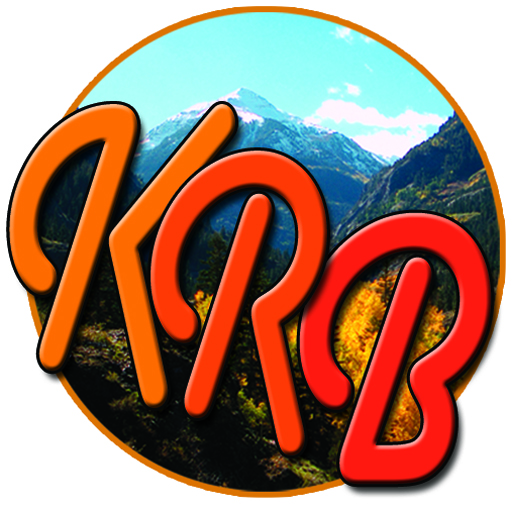Education’s New True
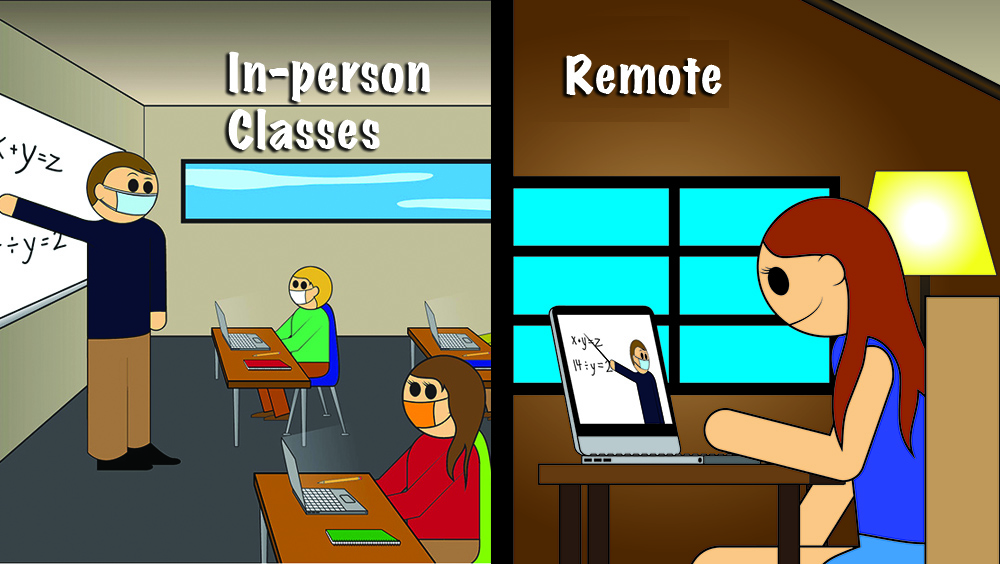
Hybrid Education. Illustration, Bryce Chismire.
[San Juan Silver Stage | September 2020 | Kathryn R. Burke]
[Author note: This article was written during the height of Covid, when schools, students, teachers, and parents were struggling to figure out how to keep kids educated… and safe. This is one of a series of articles sponsored by Elevate Internet, which provided the most reliable high-speed internet in the Montrose, Colo. area. The company also made affordable Wan and Lan Internet programs available to students and schools.]
I’m sitting here at the Stone House in Montrose, eating lunch alone and paging through news stories and background material on my phone while I wait for my food to be served. I look up information for this article and immediately I am bombarded with a landslide of “facts.” I Googled “education” and it returns about 5,820,000,000 results in 0.70 seconds. Narrow it down to “US new education” and up pop about 3.860.000.000 suggestions. The ice hasn’t even melted in my iced tea and already I’ve got too much information. Now I have to figure out which of it to trust, what to “open” and read. TMI—It’s an all-to-common conundrum in our digital world.
I miss the library. Only now, or at least here, I can eat lunch while I peruse reading material—or more accurately, peer at it through my “cheaters” on the teeny screen of my IPhone. The learning experience for all of us—student or writer, those disseminating information or those absorbing it—has irrevocably changed. Better? Not sure. Quicker? Definitely. Confusing? Absolutely.
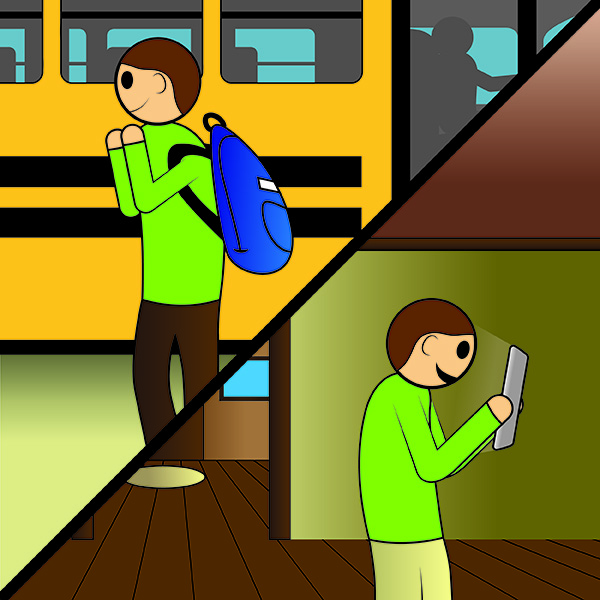
Backpacks are giving way to tablets. Lot easier to carry! Illustration, Bryce Chismire.
The face of education has been changing for a long time. Slowly at first, perhaps, but as new traditions replace old, the tried and true fades into nostalgia. A fast-paced digital world is now the new true. Backpacks of books are no more, and we seldom see turtle-backed kids headed home with mounds of homework. Today, it’s a tablet and smart phone and high-speed Internet to meet high-speed learning.
Remember the Encyclopedia? It came in sets of multiple hard-cover books with lots of small print. Ditto the dictionary. The “unabridged” book was to big to fit in a single volume. Library cards? Indexed and the size of a recipe card. And handwritten reader cards stuck in a paper pocket inside the cover of the book (handy to see if you checked it out and read it before; interesting to see who else had read it, too). Or was all that “before your time.”
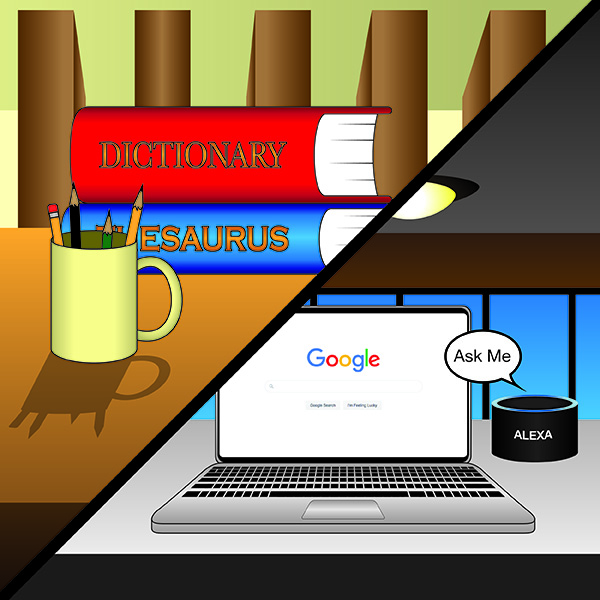
Today’s education tools gave gone from bound books to digital devices. Illustration, Bryce Chismire
Today, if you want information, you “look it up” visually or verbally online. You Google it, punching a question into your keypad. Or, ask Siri or Alexa with a voice command. There’s a digital copy of just about anything every printed in any language ever read, spoken, or sung. Unfortunately, not all the answers are the right ones. What is the right answer? Who can you trust? Do you turn to fact-checking, ask Snopes to verify? Somebody, somewhere in the vast universe of the nebulous Internet is willing to sell you “what “you deserve” to have or “teach you” what you “need to know,” often pontificating with dubious credentials and questionable veracity. History is re-writing history with a keystroke…and we’re all complicit.
How to cope? How to tell what’s true or not, accurate or “fake news?” To weed through the rhetoric and learn from the past in order to plan for your future?
For learners (of all ages), structured education through accredited school systems provides hope and help. Although it’s easier for younger teachers to grasp the newest learning systems than older ones.
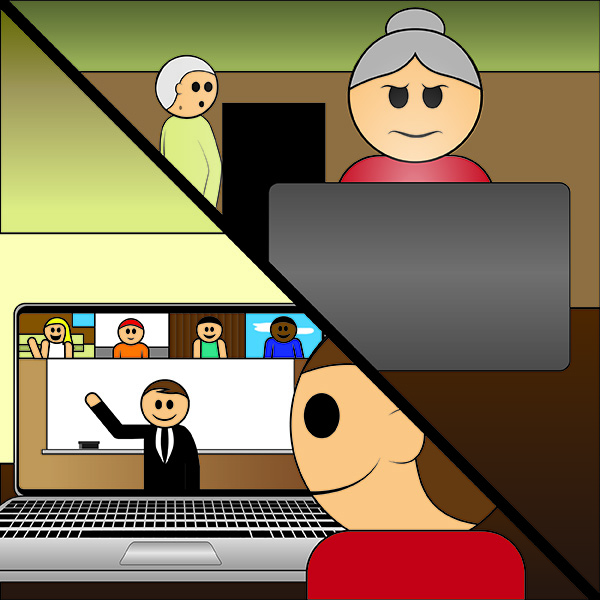
For our senior educators, the new education sometimes comes with a substantial learning curve. The transition is much easier for younger teachers. Illustration, Bryce Chismire.
For our “senior” educators mastering remote learning comes with a substantial learning curve. They didn’t grow up with computers, let alone hand-held “devices.” It’s a whole new language to that group.
For younger teachers, not long out of school themselves, the transition is nearly seamless: a learning tool becomes a teaching tool. And for kids, already tuned into technology, almost from birth, the student is often the teacher. I asked my neighbor’s 9-year old son, Max, to set up my Alexa and figure out a system problem on my IMac. “Piece of cake,” he said. And, for him, it was.
Max is just a kid but like most kids his age, he’s already comfortable with increasingly complex technology. He does his homework on a laptop, attends virtual classes with his tablet, which he also takes with him when he attends a class a couple times a week.
Maybe for Max mastering the new education model is a snap, but for today’s educators and administrators faced with critically changing technologies, it’s often an uphill battle. That changing face of education means devising a hybrid of remote learning and in-person teaching using a variety of digital tools. Lesson planning takes on a whole new meaning. The blackboard is also a computer screen. Teachers are reaching out to kids at home while interacting with those in the classroom…at the same time.
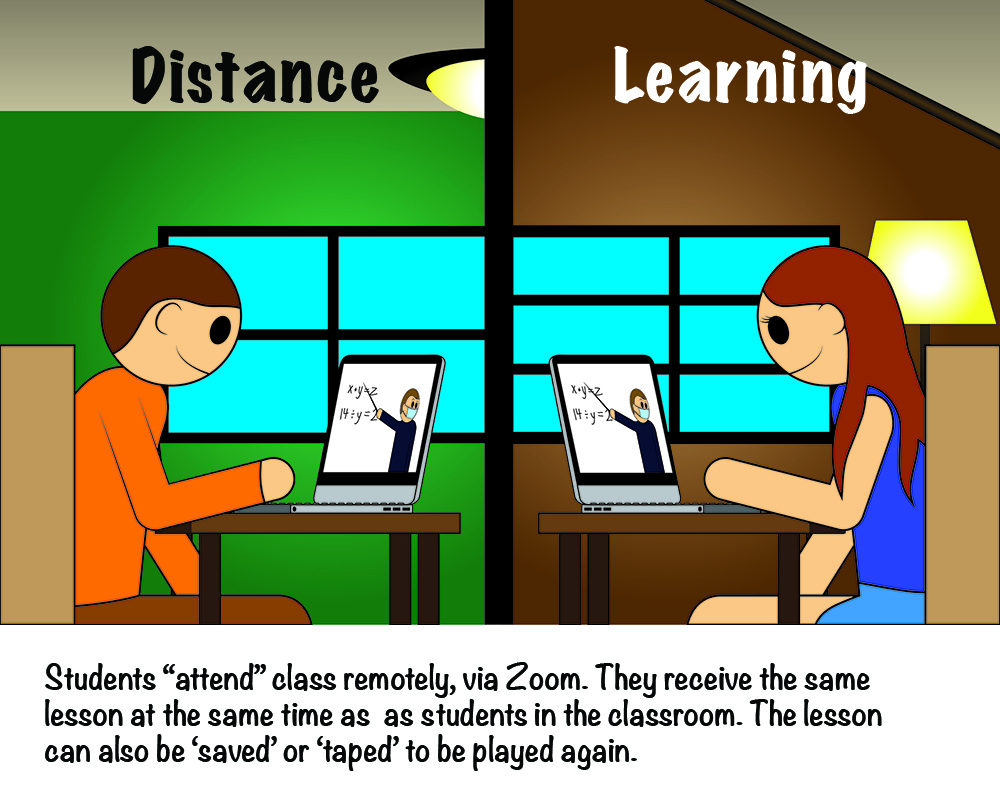
Distance Learning. Illustration, Bryce Chismire.
And now, we have Covid, further complicating educational objectives and methods. For some, distance-learning is no longer a parental preference or school system’s choice. It’s a mandate. Which sometimes comes with a critical loss of interpersonal relationships between students and teachers. It’s hard for the teacher to read negative body language—such as from trouble at home or because of learning difficulties—when viewing the child remotely through a computer screen. And what about no touching and social distancing when elementary kids need human comfort, especially at the start of a new school year, or when they take a tumble during recess?
For families, online education can be a challenge—having to teach subjects they may not know nothing or very little about. It can also be a burden, juggling time between teaching, work (often at home now), family, and personal time. Home schooling can be exhausting. And for families with children ranging from elementary through high school, scheduling takes a toll.
But where schools are fully or partially shuttered, teachers and students quarantined, home schooling may be the only option. Even with a plethora of high-tech tools, it’s a struggle. And if it goes on too long, education suffers, and we foster a generation of young people subject to learning deficits. Add to that parents having to work, so grandparents are doing the teaching—and theirs is not a tech-savvy generation. They did their learning from schoolbooks – the kind with paper pages not battery-powered screens. Their vocabulary was—and mostly still is—virtual, in the true sense of the word.
So, yes, embrace it or not, we—parents, students, and teachers— are faced with a new system of educating, one that requires learning new skills and mastering rapidly-changing technology. New traditions replace old, the familiar fades into nostalgia. Bye bye paper books and lead pencils. Hello Google and high-speed Internet. A fast-paced digital world is now Education’s New True.
